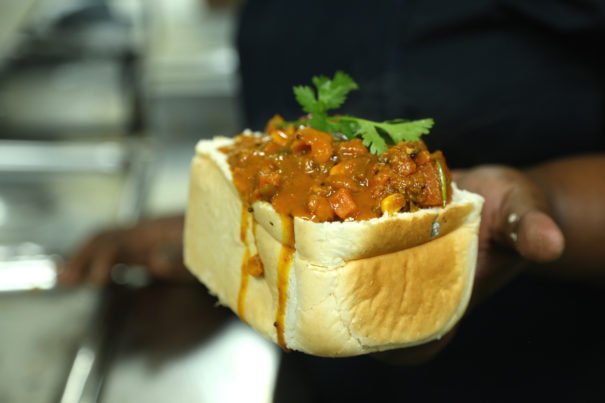
Delicious, Delicious Bunny for Breakfast

Delicious, Delicious Bunny for Breakfast
Bunny Chow in Durban
“Do you want to go out for a bunny tomorrow morning?” asked my friend in Durban, keen on showing me a slice of local life. I was appalled for a moment, imagining fluffy little rabbits being roasted for a meal. “Bunny chow,” he explained with a laugh, seeing the look on my face.
“But never call it bunny chow in Durban, it immediately marks you out as an outsider,” he added.
Well, of course I wanted to try the bunny chow. As a vegetarian, I had been seeing people tuck into all kinds of exotic meats, from ostrich to wildebeest, while I quietly picked at my salads. So I was delighted to finally get a chance to try a vegetarian snack, and Durban’s signature dish, at that.
The bunny chow is a simple dish at heart, a hollowed half loaf of bread, filled with a spicy curry of chicken, mutton, or vegetables and kidney beans. It is a hot favorite among both locals and visitors, and found everywhere in the city.
The origins of this dish are unknown, with many theories floating around. The most popular one is that it was created by and for the community of Indian laborers working in the sugarcane plantations of Kwazulu Natal (a South African region, of which Durban is the largest city).
Thousands of Indians migrated to South Africa in the mid 19th century in search of work, and Durban today has the largest Indian diaspora anywhere in the world.
When the plantation workers found it difficult to manage an elaborate lunch during their quick midday break, a clever housewife hit upon the idea for this one-dish meal of bread and curry that can be eaten without cutlery. The name itself is believed to have originated from the Hindi word for someone from the trading community, ‘bania.’
And so that mild winter morning, we headed to Oriental Restaurant, known to be one of the best bunny places in town. Located inside the buzzing Workshop shopping mall, the café had an unassuming façade, basically an open counter with plastic tables lined up on the corridor outside.
Seeing my great curiosity about the dish, the manager invited me into the kitchen to see how it is made. It was a neat assembly line process, with people clearly practiced in their task: cut, scoop, fill, garnish and serve.
And then it was time for me to taste my bunny with the vegetables and kidney beans filling. Soft, warm and messy, this is a dish best suited for eating with the hands, and that was what I did. By the time I ate, the curry—generously seasoned with Indian masalas—had soaked into the bread, making it all the more flavorful.
As for me, it was love at first bite. It was the familiar taste of home, with a faint tinge of the exotic; what was not to love? And in that single bite, I understood the kind of charm the bunny chow has held for subsequent generations of Indian immigrants.